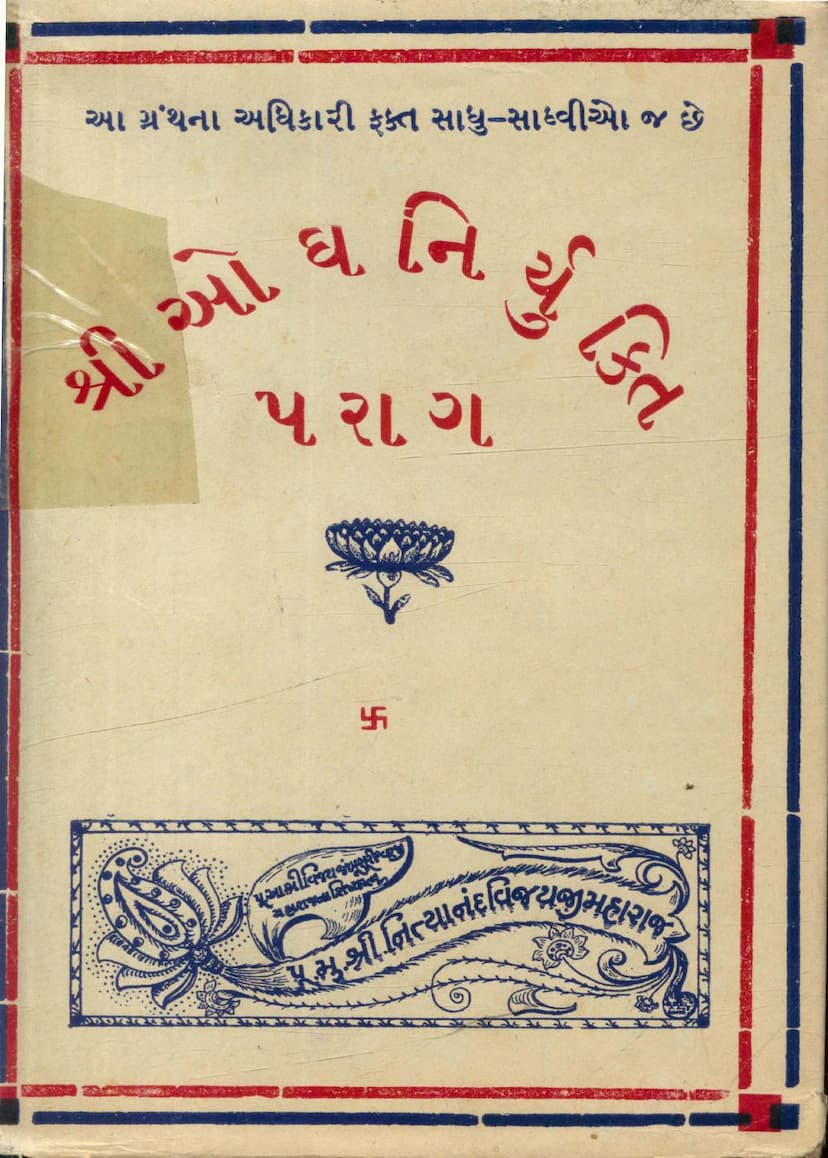Ogh Niryukti Parag
Added to library: September 2, 2025

Summary
Here's a comprehensive summary of the Jain text "Ogh Niryukti Parag" by Nityanandvijay, based on the provided pages:
Title: Ogh Niryukti Parag Author: Nityanandvijay Publisher: Jambuswami Jain Muktabai Agam Mandir Catalog Link: https://jainqq.org/explore/023165/1
Core Purpose and Audience:
The book is primarily intended for Jain monks and nuns (Sadhu-Sadhvi), as explicitly stated on page 1. Its central aim is to guide them in the proper and devout observance of their daily conduct and rituals, promoting character purity and adherence to Jain principles. It's presented as a foundational text that will facilitate a deeper understanding of the original scriptures.
Key Themes and Content:
The "Ogh Niryukti Parag" is a commentary or elaboration on the "Ogh Niryukti," a foundational Jain text dealing with the conduct and rules for monks and nuns. The book aims to simplify and explain the complex original text, making it accessible to those who may not have extensive knowledge of Sanskrit and Prakrit.
The content is structured around the core tenets of Jain monastic life, focusing on Charan Karyananuyog (the branch of Jain literature that deals with conduct and practices). The book delves into:
- The Importance of the Ogh Niryukti: It explains that the Ogh Niryukti was compiled by the venerable Shri Bhadrabahu Swami, a fourteen-purva holder, to benefit monks and nuns by making the essential rules of conduct more easily accessible. Originally a part of the ninth purva, it was extracted for practical guidance.
- The "Seventy-Seven" of Conduct (Charan Sottari): The book details the "Charan Sottari," which encapsulates seventy essential principles or practices for monks and nuns. These are divided into categories such as:
- Vratas (vows)
- Shraman Dharma (monastic duties)
- Sanyam (restraint)
- Vaiyavachhya (service and respect for elders and the needy)
- Brahmacharya (celibacy)
- Gyanaditrik (knowledge, perception, and conduct)
- Tapas (asceticism)
- Krodhadhi Nigrah (control of anger, pride, deceit, and greed)
- The "Seventy-Seven" of Action (Karan Sottari): Similarly, it outlines the "Karan Sottari," comprising seventy practices related to action and behavior. This includes:
- Pind Vishuddhi (purity of alms)
- Samiti (carefulness in actions)
- Bhavana (meditations and contemplations)
- Pratima (stages of ascetic practice)
- Indriya Nirodh (control of senses)
- Pratilekhana (careful examination of objects)
- Gupti (restraint of mind, speech, and body)
- Abhigrah (vows and resolutions)
- Seven Doors (Dwara) of Ogh Niryukti: The book elaborates on the seven key sections of the Ogh Niryukti:
- Pratilekhana Dwar: Detailed guidelines on how to examine oneself and one's surroundings.
- Pind Dwar: Rules for pure alms-seeking and consumption.
- Upadhi Praman Dwar: The appropriate quantity and type of possessions allowed.
- Anayatan Varjan Dwar: What places to avoid and why, focusing on maintaining purity of conduct.
- Pratisewana Dwar: Understanding and avoiding faults and transgressions in conduct.
- Alochna Dwar: The process of confession and expiation of faults.
- Vishuddhi Dwar: Achieving purification through the proper observance of penances and practices.
- Detailed Explanations: The text provides practical examples and elaborations on each point, often using analogies and stories to illustrate the principles. This includes discussions on:
- How to behave in different situations, like facing calamities (drought, royal fear, fear of robbers), and the reasons for resorting to solitary journeys (ekaki).
- Rules for entering villages, interacting with householders and other ascetics.
- The meticulous process of examining items, eating, and staying in residences to avoid harming subtle beings (nigoda) and maintaining purity.
- The importance of controlling senses and mind, and the different types of vows and austerities.
- Emphasis on Guru-Gnosis: The text stresses the importance of learning and practicing these principles under the guidance of a knowledgeable guru.
Context and Significance:
The book is presented as a contribution to Jain literature and spiritual practice. The publication is dedicated to Acharya Shrimad Vijay Prem Surishwarji Maharaj and Acharya Shrimad Vijay Jaboo Surishwarji Maharaj, highlighting the lineage and respect within the Jain tradition. The "Prasangik" section (page 11) traces the lineage of Jain knowledge from the Tirthankaras to the current era, noting the gradual decline in knowledge and the importance of preserving and transmitting the scriptures.
Overall Impression:
"Ogh Niryukti Parag" is a scholarly and devotional work that aims to preserve and propagate the essential guidelines for Jain monastic life. It emphasizes diligence, mindfulness, and the unwavering commitment to ethical conduct as pathways to spiritual liberation. The detailed explanations and structured approach make it a valuable resource for monks and nuns seeking to deepen their understanding and practice of the Jain way of life.